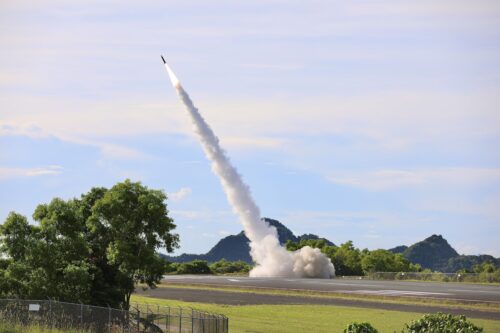The U.S. Army’s 3rd Multi-Domain Task Force (3MDTF) successfully showcased its ability to operate in the vast Indo-Pacific theater during the recent Valiant Shield 24 exercise. The exercise, which took place across multiple locations in the Pacific, highlighted the 3MDTF’s proficiency in distributed command and control, emerging technologies, and long-range strike capabilities.

Photo: U.S. Army
The 3MDTF deployed teams across several locations, including Japan, Guam, and Palau. These teams operated independently while collaborating through a central All-Domain Operations Center (ADOC) located in Oahu, Hawaii. This distributed approach simulates real-world scenarios where forces might be geographically separated but need to function as a cohesive unit.
The exercise also served as a testing ground for innovative technologies. In Guam, the 3MDTF partnered with the Office of the Undersecretary of Defense (OUSD) and industry to launch high-altitude balloons (HABs) equipped with electromagnetic sensors and mesh communication systems. These HABs collected valuable data to enhance future maritime domain awareness efforts.
Meanwhile, Platform Aerospace showcased its Vanilla Ultra-Long Endurance Unmanned Aircraft System (UAS). Vanilla boasts the world record for continuous, unrefueled flight of a combustion engine aircraft, exceeding 8 days. During Valiant Shield, Vanilla functioned as a communication relay, operating effectively for 27 hours, even weathering a severe storm. This successful demonstration underlines the potential of ultra-long endurance UAVs for persistent intelligence, surveillance, and reconnaissance (ISR) missions.
The 3MDTF also participated in the exercise’s SINKEX (Simulated Sinking Exercise) event, utilizing the U.S. Army Autonomous Multi-Domain Launcher (AML) and two Precision Strike Missiles (PrSM) in Palau. This marked the first time both the AML and PrSM were employed outside the continental US. The AML, a prototype launcher designed for autonomous operations and long-range strikes, successfully engaged a moving maritime target in collaboration with other joint forces.
The PrSM itself deserves a closer look. While the press release doesn’t explicitly state the variant used, it’s worth considering the ongoing development of the PrSM Increment Two, also known as the Land-Based Anti-Ship Missile (LBASM). This variant is specifically designed to address the growing need for land-based anti-ship missile capabilities.
The LBASM leverages the PrSM’s baseline capabilities, including a range exceeding 400 kilometers and a high degree of accuracy. However, it incorporates a new seeker head optimized for targeting ships, even in challenging weather conditions. This capability fills a critical gap for the U.S. military, particularly in the Indo-Pacific where vast distances and potential anti-access/area denial (A2/AD) strategies employed by adversaries necessitate long-range, land-based anti-ship missile options.
While the press release doesn’t confirm a LBASM test during Valiant Shield 24, the exercise scenario and the participation of the AML – a platform well-suited for launching both the PrSM and LBASM – make it a distinct possibility. If successfully tested, this would represent a significant step forward in the development and deployment of this crucial anti-ship missile capability.
The exercise highlighted the crucial role of the 3MDTF’s All-Domain Operations Center (ADOC) located on Oahu, Hawaii. The ADOC, along with a Battalion command post in Japan, functioned as the central hub for coordinating operations across the vast Indo-Pacific theater. Valiant Shield provided invaluable training opportunities for the 3MDTF to integrate with partner nations and allies, fostering deeper collaboration and enhancing multi-domain warfighting readiness.
Colonel Michael Rose, the 3MDTF Commander, emphasized the significance of the exercise: “Valiant Shield enabled us to integrate with the Combined Joint Force and operate distributed while forward in theater. We were able to build new relationships and continue to deepen existing ties. Valiant Shield and like exercises in the region enable us to test our systems and processes as well as integrate new capabilities alongside our partners and allies, contributing to the continuous transformation of our multi-domain capability and increasing our warfighting readiness.”
For more information, hit the Source below